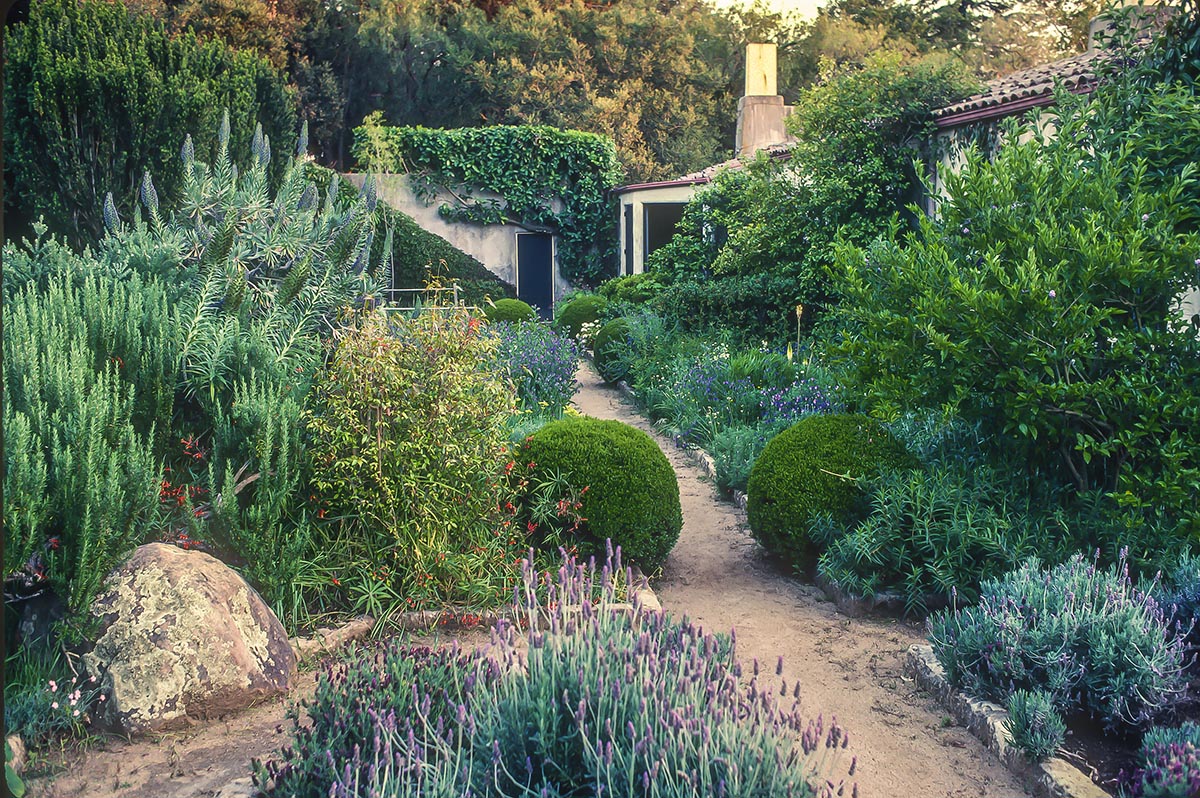
Grazing on the Landscape

Contributor
- Topics: Nature is Good For You, Plants You Need
Fall 2024
When I was a child, wandering in a big backyard planted in ornamental plants, fruits, and vegetables, I liked to graze on plants I knew I could eat and pretend I was gathering from the wild. It is probably a human instinct to want to wander about among plants and gather what is edible. You may have planted your garden to be an ornamental one, but you can still find food in it and find the joy in doing so. If you imagine yourself gathering from the wild, I won’t tell.
Some common and widely adapted ornamental plants offer a chance to forage in a garden. Let’s start with the rose (Rosa), a garden standby in many climate zones. The edible parts are the flowers and the hips. If your roses are not treated with toxic pesticides, use the petals in salad, candied, or chopped in pies or scones. The hips, or fruits, of rose have long been used in making jelly, syrup, or tea.
While roses are grown throughout the region, your microclimate will influence the variety you choose. In mild-winter areas, you’ll want a rose that needs little chill—in colder places, hardier ones. Flowers with 30 or fewer petals are well adapted to areas that are cool and foggy, whereas those with over 30 petals need more warmth to open and do better in dryer, warmer inland areas.
Disclaimer: Pacific Horticulture presents these foraging articles for information purposes only. Pacific Horticulture does not encourage or endorse wild foraging without proper training and/or supervision of an expert.
Those who intend to forage in the wild assume all responsibility and liability inherent in such pursuits. Pacific Horticulture cannot be held liable for any misidentification, adverse reaction, or other unforeseen outcome from the act of wild foraging.
We want to emphasize that this article is not a field guide. Our article and images are not intended to be a scientific representation of specific plants for the purposes of identification for eating. Please contact an expert forager before consuming anything found in the wild.


We often discover, when garden foraging, that the ornamentals we have chosen to plant are not the best-flavored or best-textured varieties. In the case of roses, the most flavorful petals tend to come from the most sweetly scented varieties. Look for lists of roses with the best-tasting hips for your region. They usually include dog rose (R. canina), beach rose (R. rugosa), and several hybrid cultivars, especially shrub and climber varieties.
Rose hips ripen in late summer and fall, usually to orange or red. Of course, they won’t form if you are deadheading blossoms, and some hybrids will not form hips at all. It is best to remove the white base of rose petals, which may be bitter. If you plan to eat rose hips raw, be sure to scrape out all the seeds first, as they are accompanied by hairs that will cause itching. No need to remove seeds if you are drying or cooking the hips.
Food from the Perennial Border
Hostas (Hosta) are American gardeners’ favorite perennial. They are hardy in US Department of Agriculture (USDA) hardiness zones 3–8, with some varieties thriving in Zone 9. They grow best where winter is cold and wet, so they are not a good choice for places with dry soil or air. Japanese chefs peel the furled leaves off spring shoots that are foot or less tall, then sauté them to serve as a vegetable called urui. Their flavor is described as between that of scallions and of asparagus. The plants tolerate the harvest of their earliest shoots well, growing back to make a good stand of ornamental plants.
Hosta varieties vary in flavor and in shoot size, and size does not correlate with flavor at all. The Achilles’ heel of hostas in gardens is their palatability to slugs and snails. The plant requires a gardener’s close attentiveness, particularly where the brown garden snail (Cornu aspersum) survives winter and multiplies rapidly.
Another edible plant in many gardens is the bellflower (Campanula), the flowers and leaves of which are edible. Some bellflowers are rampant spreaders, even weeds, so it’s good to know we can put extra leaves into salad or soup. Some are so mild as to be considered bland, others are mildly sweet. Most bellflowers are perennials and vary in hardiness and adaptation, since some species are native to the Mediterranean area, while others are from mountainous regions, including tropical mountains.

Lily-like, but not lilies
Another widely adapted ornamental edible is the daylily (Hemerocallis). Most species are hardy in USDA Zones 4 to 9, though some cultivars have been successful in Zones 1 to 11. Gardeners select cultivars for adaptability to particular climates as well as for period of bloom. Some bloom for three to four weeks, others rebloom throughout the summer. While you can eat the flower petals, the claim to fame for daylilies are the dried buds, known as “golden needles” in Chinese cuisine.
To harvest daylily buds, break off those that are mature but not open. You can use them fresh in any way you’d use green beans, or you can dry them. To dry them, first parboil them for three minutes. Then drain them and put them in a dehydrator or between sheets of newspaper in a warm, dry place. When they are dry, they can go into a closed jar.
Daylilies are not true lilies. They are not in the genus Lilium or even the same family as true lilies. All parts of true lilies are toxic, as are all parts of daffodils (Narcissus). Don’t eat true lilies or daffodils.
We do eat the leaves, flowers, and bulbs of some plants that are more closely related to lilies than daylilies—onions and garlic (Allium), for example, as well as society garlic (Tulbaghia). They are perennials, but if the plant forms bulbs and you eat its bulbs, the plant will not return the following year.
While they were once all classified as lilies, alliums are now in the amaryllis family (Amaryllidaceae). The edible members have a strong onion or garlic odor. If you think a plant is an onion relative, but it doesn’t have this scent, don’t eat it. Most ornamental alliums are edible, though they vary in tastiness. One, giant allium (Allium giganteum), is known to be somewhat toxic, as it contains a higher amount of a sulfur-containing compound than other alliums.
Garlic chives, or Chinese leeks (Allium tuberosum), are hardy to Zone 4 and are often grown for their flat heads of small, white flowers. The leaves may be used as a chive substitute or as a vegetable in a stir-fry. The allium relative society garlic (Tulbaghia violacea) is hardy in Zones 7–11. In late summer, society garlic has loose heads of small flowers that are lavender or pink and tubular then flaring. Some cultivars have white-striped leaves and flowers. Society garlic is said to offer a garlic flavor without producing garlic breath.
Canna lilies (Canna) are edible plants that are not lilies at all, but more closely related to ginger and bananas. They are usually grown for their bright flowers, but all parts of the plants are edible. The most commonly eaten part is the thickened rhizome, which can be peeled, chopped, and added to dishes much as if it were a potato.
There are agricultural canna varieties, and also many cultivars. The ones bred for showier flowers are edible but may not have very large rhizomes. Your best bet for a rhizome harvest is purple arrowroot (Canna edulis, syn. Canna indica) (Brickell and Cathey 1997). This plant of the Americas was falsely thought to be from India or Africa. This one has yellow or red flowers that are smaller and less showy than hybrids. The leaves of all cannas are also edible, used as a wrapper for cooked foods, or, in spring, when they are young and more tender, used in salads or stir-fries.

Canna plants are only hardy to Zone 7 (0°F or -18°C) but the rhizomes can be dug and stored over winter, allowing the plants to be grown even in Alaska. Just be sure it is canna lily that you sample, not calla lily, an arum, which is toxic.
Canna sap can also irritate some people’s skin. Check for allergy symptoms on your skin, and allergies of potential diners, before you serve them Canna.
Drought tolerant and tasty
Prickly pear cactuses (Opuntia) are an edible plant that are often grown in drought-tolerant gardens. They are hardy to light frost, grow 10–15 feet (3–4.6 meters) tall and wide, and do particularly well in high heat. They grow adequately in cool, coastal microclimates, though may not fruit as freely. They are often planted as a barrier plant, to prevent unwanted access to a garden or home. The name fig opuntia (Opuntia ficus-indica) is used for the ones bred to be eaten, but all Opuntia species are edible, and some smaller species survive much cooler winters. Fruit quality varies considerably among Opuntia species with some fruit being small, fibrous, or poorly flavored, and others bearing large, tasty, and succulent fruit.
Cross-Atlantic markets include only the fruit, which is grown mostly on the island of Sicily. However, in the US and in Central America, people eat both fruit and pads. Cut young pads in spring when they are nearly full size. Remove thorns and cut the pad up. The resulting vegetable tastes much like green beans, with a bit of mucilage, like that of okra. In Spanish, the pads are called nopales, the cut-up pads nopalitos.
The spines cause more concern than they deserve. I have cleaned spines from many a pad without injury, either with a knife or using my fingernails. I work from the base of the pad, since the spines point toward the other end. In Mexico, some people clean spines from the fruits (called tunas) by rolling them on dry ground. In the US, people might remove the core to eat it, as a bartender removes the center of a lemon, or they may turn the fruit on a spit over flame briefly to burn off the spines.

Prickly pear is not the only succulent that is edible. Species of Echinocactus (such as Mexican barrel cactus, E. grusonii) and of Ferocactus can also be eaten, though I am at a loss to know when you might want to sacrifice one of these beauties to eat them, or how you would remove their densely packed sharp spines. Other succulents you can eat include some stonecrops (Sedum) and elephant’s food (Portulacaria afra)—a tender, shrubby plant common in Southern California. A few Portulacaria leaves are nice in a salad. They have a lemony tang similar to that of purslane. The stonecrop cultivar Autumn Joy (Sedum ‘Autumn Joy’), which is hardy to Zone 3, is rated high for flavor and is good in stir-fry, soup, or salad. (Young leaves will always be better to eat than mature ones.)
Tropical flavors
Many edibles are grown as ornamentals on the Hawaiian Islands, from the kukui tree (Aleurites moluccana)—also known as the candlenut tree—to edible hibiscus (Abelmoschus manihut). Candlenuts are toxic, but cooking eliminates the toxicity. (Some commonly eaten foods must also be cooked to denature toxins. For example, raw kidney beans contain toxic compounds that are made harmless by cooking.)
People who eat candlenuts remove the nut meats, roast them, and then chop or grind them to use as a thickener for curries. Hawaiians eat roasted, ground kukui with seaweed and salt as a condiment, or use them ground with salt in the dish poke. They taste a little like walnuts. If you find your candlenuts are bitter, you may have a bitter variety and might want to try another.
On the other hand, edible hisbiscus contains no toxins at all, nor does any hibiscus or the related mallows (Malva) or flowering maples (Abutilon). People eat the large, soft leaves of edible hibiscus raw, steamed, boiled, stir-fried, in soup, or as a wrapper for other foods. They may also eat petals of the flowers. The Cooperative Extension Service of the University of Hawaiʻi has published an excellent, illustrated article on edible ornamental plants commonly grown there, with evaluations as landscape plants (Wong 2006).


Natal plum (Carissa macrocarpa) is one plant grown in Hawaiian ornamental landscapes as well as in frost-free mainland locations, especially near the coast. It is a shrub, 5–7 feet (1.5–2.1 meters) tall, but often pruned shorter, with clusters of white flowers and short, forked thorns. Its oval fruit is about two inches (one centimeter) long and red when ripe. All parts of the plant except the ripe fruit contain the same toxin as its relative, oleander (Nerium oleander). The sap of the plant, a white (milky) latex, is off-putting, but, in fact, the presence of latex in the fruit is an indication that it is ripe enough to eat. (Just don’t cook it in an aluminum pot since the latex will stick to the pot.) Natal plum has a thin skin, and its flesh has flavor of a cranberry and the texture of a strawberry. There are 6–16 seeds that can be taken out, spit out, or swallowed whole. The fruit may be eaten raw or cooked. Natal plum is used in pies, fruit salad, sauce, or gelatins.
Maybe tasty?
Some fruits borne by ornamental shrubs or trees are edible, but usually bland. One example is fuchsia (Fuchsia). Its fruit is a shiny, dark purple berry that is tender and typically only slightly sweet. Not all fuchsia hybrids produce fruit, and if they do, one must pay attention to the plant to sample them, as the fruit tends to fall to the ground when ripe. (If you’ve had bad experiences with fuchsia mite (Aculops fuchsiae) infestations, look for species and modern hybrids that are not susceptible.)
The strawberry tree (Arbutus unedo) bears soft, bright red fruits that are edible, but they are so bland that people joke that the specific epithet—unedo—stands for “You need only to try one.”
On the other hand, there are ornamental shrubs and trees that have quite tasty fruit. Bush cherry, or Nanking cherry (Prunus tomentosum), is a shrub that succeeds in zones 2–7. (Milder climates provide too little chill.) The spring show of white blossoms is spectacular, and the three-quarter-inch (one-centimeter) red cherries may be used like any sour cherry.
A less hardy edible ornamental is pineapple guava (formerly Feijoa sellowiana). In Zones 8–11, it provides small fruit that many find delicious and red-and-white flowers that are sweet and tasty as well.

Kousa dogwood (Cornus kousa), a popular type of dogwood tree that thrives in Zones 5–8, produces masses of white or pink flowers (well, bracts), then red-orange fruit with a yellow-orange interior. Some trees’ fruit is tastier than others, since the tree was bred for flowers, not fruit, but it is often quite flavorful. Kousa dogwood fruit is best eaten raw and doesn’t keep well. Spit out the seeds.
Barberry (Berberis), are a striking example of a popular ornamental plant that have tasty but rarely planted cultivars. Their fruit varies greatly in flavor, size, and ratio of flesh to seed. You may luck out and find you have a pretty good cultivar, but the best is a seedless variety of barberry (Berberis integerrima ‘Bidaneh’) grown commercially in Iran for its large, flavorful, seedless fruits. A nursery or two in the United States has offered this particular variety, but it is unlikely to be in your garden.
After Iranian seedless barberries, the next most palatable fruit is that of European barberry (Berberis vulgaris), but it is classified as invasive in a number of US and Canadian locations, so it is rarely planted. Its fruit is tart; some would say pleasantly tart.
The most common species in American gardens—Japanese barberry (Berberis thunbergii), also known as Thunberg’s barberry—is not as tasty. The palatability of barberry fruit is determined by the amount of the chemical berberine it contains. People who are pregnant, trying to become pregnant, or breastfeeding should avoid this chemical.
The Iranian seedless species is traditionally dried and then used in savory, rather than sweet, dishes, such as the rice dish zereshk-polo, soups, stews, or in stuffing for chicken. All barberry fruit is high in the pectin that makes jelly gel, so regardless of the flavor, it is a good addition to jelly made with other fruits. Do be careful of the long thorns when you pick the berries, just as you would be when picking blackberries from thorny plants.
Tall Oregon grape (Berberis aquifolium), and other plants commonly known as mahonia, have been reclassified as Berberis species. Like those of the plants traditionally known as barberry, mahonia berries are edible. They are tart and a bit astringent, but may be dried and used in savory dishes or to make wine. Oregon grape is native from Alaska into Northern California, best in Zones 5–7, and better to plant than the similar-leaved holly (Ilex), most species of which may be invasive where you are.
Seasonings from the landscape
Last, but not least, are two herbs you can harvest from ornamental plants, one well known, another less known to most American cooks: rosemary (Rosmarinus officinale) and sumac (Rhus). Rosemary grows well throughout mild-winter parts of the Pacific region in Zones 8–11. It doesn’t mind high heat and also thrives in cool coastal climates. Given loose, not-too-wet soil, it will also grow in tropical locations. The cultivar Arp rosemary (Rosmarinus officinalis ‘Arp’) is hardy to a few degrees below most rosemary varieties. Try also Chef’s Choice Rosemary (Rosmarinus officinalis ‘Chef’s Choice’ aka ‘Roman Beauty’) which was bred for more tender leaves and higher oil content.
Rosemary varies from creeping to tall plants, from draping to upright. All will produce far more leaves or small branches for seasoning than you will ever need. It is nice to have a plant nearby for fresh herbs, because you can cut up fresh leaves or branch tips with kitchen scissors or a knife, while dried ones require a mortar and pestle to break the leaves into small pieces. If you are harvesting while the plant is in bloom, mind the bees!

Sumac berries are used in the Mediterranean region to make a tasty and popular spice—tart but not astringent. Sumac is also the common name of a plant that causes contact dermatitis similarly to poison oak and poison ivy. Those pesky plants and poison sumac were once classified as Rhus, too, but all three have been moved to the genus Toxicodendron.
When it is fruiting, the itch-causing poison sumac (Toxicodendron vernix) is easily distinguished from Rhus, since its berries are smooth, white, and typically dangling—whereas those of Rhus (borne only on female plants) are reddish to red, covered with glandular hairs, and borne in upright clusters. You are unlikely to find the poisonous species in gardens. More likely it will be found growing wild in boggy places. As with other garden plants, allergies to Rhus species are possible, particularly to its pollen, but the plants are not especially allergenic.
Both poison sumac and most Rhus species have long compound leaves, with many pairs of leaflets and one on the end. They vary from low shrubs to small trees. They are also variable in hardiness, ranging from lemonade berry (Rhus integrifolia)—a low, frost-tender evergreen shrub which is native to Southern California and Northern Baja, Mexico—to one species, smooth sumac (Rhus glabra), that is hardy to Zone 2. Deciduous sumac species are grown in gardens largely for their brilliant orange or red fall foliage. The large or sprawling nature of sumac shrubs—and the plants’ tendency to sucker and spread—make them best for larger gardens. Lemonade berry, the frost-tender sumac—which has simple, rather than compound, leaves—makes a good screening hedge.

The species used to make sumac seasoning in the Mediterranean area is Sicilian sumac (R. coriaria), which is native to the area. A similar species, staghorn sumac (R. typhina), hardy in Zones 3–8, is the one most commonly used in the US to make the spice.
To prepare sumac spice, gather the upright clusters of ripe, red berries, preferably when rain has not fallen for several days. Remove them from the stems and dry them in a dehydrator or an oven set at 140–150°F (60–66°C). When they are crackly dry, whisk them in a food processor very briefly to separate berry from seed. Push the resulting berry fragments through a sieve and then discard the seeds. Store the dry sumac spice in a closed jar.
The spice blend za’atar usually contains some sumac, and sumac can be used in meat dishes, salads, and salad dressing, on cheese, or in desserts. A tea may be made by soaking the fruit stems in water in a sunny place for several hours.
If you don’t live where deciduous sumac will grow, you can still make a drink that tastes much like lemonade by soaking a half cup of fruits from the evergreen sumac (Rhus integrifolia), known as lemonade berries, in two quarts of water a half hour or longer, then sweetening it to taste (Farnsworth 1994).
Nopalitos in Tomato Sauce
Recipe from Golden Gate Gardening (Peirce 1993).
Note: If the slightly mucilaginous quality of cooked nopalitos bothers you, you can boil them for 10 minutes and then rinse them in several changes of fresh water, but truly, the trait is masked considerably in this recipe by the tomato sauce.
1 or 2 pads of prickly pear cactus
1/2 cup of chopped onion
1 Tablespoon oil (olive oil is good)
1 8 oz. can of tomato sauce
1/2 (or more) of a whole jalapeño pepper, pickled or fresh, finely chopped
De-spine the cactus pads, wash them, and then cut them into strips about 1/2 x 2 inches. Parboil and rinse them if desired.
Heat the oil in a medium skillet and add the onion. Sauté it until it is tender, but not brown. Add the nopalitos and cook over medium heat, stirring occasionally. If they are raw, cook until they turn from bright to dull green—about 5 minutes. (If you boiled them, they will be nearly cooked already.) Turn heat to low. Add the tomato sauce and jalapeños. Cook a few more minutes to heat through.
To make this a full vegan meal, use a 15 oz. can of tomato sauce. Increase the amount of jalepeño, too, if you like food spicy. When you add the tomato sauce and jalapeños, also add two cut-up, steamed potatoes and one 15 oz. can of garbanzo beans, drained. Heat all through before serving.
Disclaimer
Never eat a plant unless you are sure you have identified it correctly, know whether it needs cooking or other preparation before it is safe to eat, and know it has not been sprayed with a toxic chemical.
Be aware that plants humans can safely eat may be poisonous to other animals. Onion, for example, is toxic to dogs. Many websites are devoted to listing the plants that are toxic to various domestic animals.
Resources
Brickell, Christopher and H. Marc Cathey. 1997. American Horticulture Society’s A to Z Encyclopedia of Garden Plants. New York: DK.
Farnsworth, Kahanah. 1994. A Taste of Nature: Edible Plants of the Southwest and How to Prepare Them. Santa Fe: Ancient City Press.
Peirce, Pam. 1993. Golden Gate Gardening. Seattle: Sasquatch Books.
Wong, Melvin. 2006. “Edible Plants for Hawaiʻi Landscapes.” Landscape. L-14. Honolulu: University of Hawaiʻi at Mānoa. [pdf]
Photo Credits
- “Dog Rose” by enneafive is licensed under CC BY 2.0.
- “Beach Rose – Rosa rugosa – hamanasu” by sapienssolutions is licensed under CC BY 2.0.
- “Hosta” by Fran Veale is licensed under CC BY 4.0.
- “Sedum ‘Autumn Joy'” by nordique is licensed under CC BY 2.0.
- “File:Abelmoschus manihot ssp tetraphyllus W IMG 2157.jpg” by J.M.Garg is licensed under CC BY 3.0.
- “(MHNT) Hibiscus moscheutos – Red swamp rose-mallow flower – Les Martels, Giroussens Tarn” by Didier Descouens is licensed under CC BY-SA 4.0.
- “Kousa dogwood fruit” by Ruth and Dave is licensed under CC BY 2.0.
- “Staghorn Sumac (Rhus typhina)” by aarongunnar is licensed under CC BY-SA 2.0.









Responses